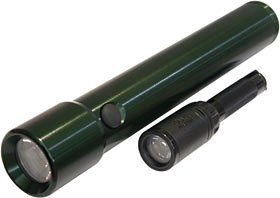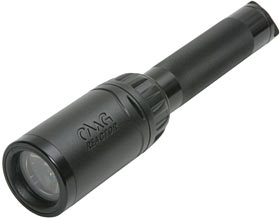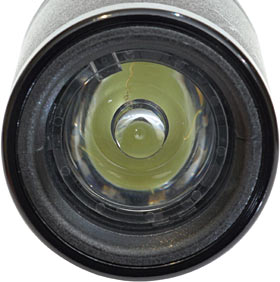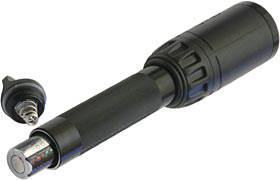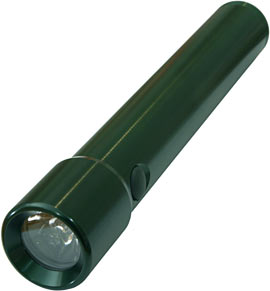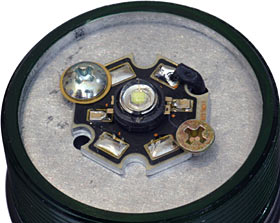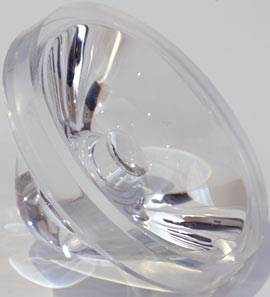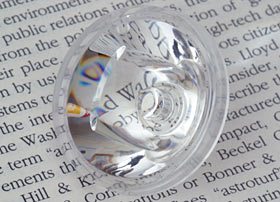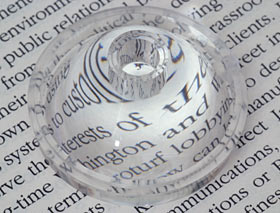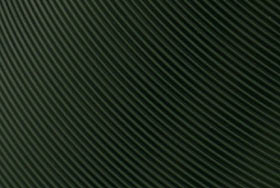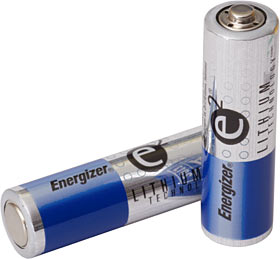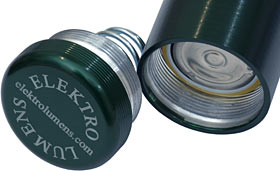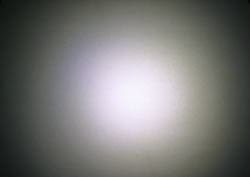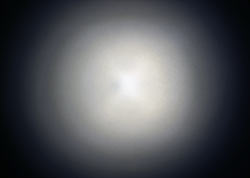
CMG Reactor and Elektro Lumens Blaster III
Review date: 25 September 2003.Last modified 03-Dec-2011.
If you haven't been keeping up with flashlight technology lately - I grudgingly accept that there are some people in the world who're less interested in these things than I am - then you're likely to be rather surprised by what LEDs can do these days.
First, there were LEDs bright enough to work as indicator lights, but nothing more. Then there were the first high-intensity clear-lens LEDs; they were useable for a pocket flashlight, if you didn't mind a red or amber beam. Then high intensity LEDs got brighter and brighter and moved further and further up the spectrum (red, amber, green, then blue). And then came white LEDs - which, thus far, are all actually blue LEDs with a phosphor blob on the die that eats some of the blue and spits out other colours to make up a pretty homogenous white beam.
The next step's the super-powered LED, a single device with output power that matches mid-range flashlight globes. Before super-LEDs arrived, the only way to get better than penlight brightness out of an LED flashlight was to use an array of LEDs. Now, though, single LEDs with power ratings of a watt or more exist.
Lumileds are spearheading the giant-LED charge with their Luxeon products...
...and here are a couple of flashlights that each use a one watt Luxeon Star as their lamp.
You might guess from the picture that despite their similarities at the business end, these two lights aren't quite aimed at the same market sector.
This is CMG Equipment's Reactor. It takes two AA cells, and has about the Mini Maglite dimensions you'd expect from such a light, except for its bulky lamp assembly.
The lamp includes a rotating off-on-off detent switch; you turn the lamp to turn the Reactor on, and can then keep turning it the same way to turn it off again, if you like. If you over-turn the lamp it'll click alarmingly, but the switch seems to deal with this abuse without complaint. The lamp also has a metal ring around its protruding front edge, to protect it from drop damage. It's built to last.
It's also a bit of a pig to disassemble, so I left it in one piece.
The lamp contains what looks like a standard "Star/O" lamp package - a Luxeon Star LED with a collimating lens assembly on top of it. The Star/O is what you usually get in Luxeon-powered flashlights, and it gives a usefully broad beam, feathering off gradually at the edges, with a definite "hot spot" in the middle.
A broad beam is what you want for ordinary seeing-where-you're-going and indoor flashlight use, and the Reactor delivers; it delivers a useful light puddle at least 70 centimetres wide at a distance of only metre.
The lamp's sealed; you undo the tailcap to put batteries into the light. The body of the light is made of aluminium, and is very solid. The tailcap also has an O-ring seal to keep out water, though the light as a whole is only rated as "water resistant".
And now for something almost completely different.
This is the Blaster III, one of Elektro Lumens' Blaster series lights. It was originally born as the Blaster II, but some revisions resulted in a new name; if you try to buy a Blaster II today, they'll send you a Blaster III.
The Blaster III is not a pocket flashlight, at least not for anybody who can't use the Arc de Triomphe as a croquet hoop. It's a hefty three-D-cell light, similar in overall dimensions to a three-D Maglite, but with a smaller lens assembly.
That smaller lens is the Blaster's claim to fame.
The great thing about super-LEDs, see, apart from removing the need for honeycombs of little LEDs, is that they allow the light to behave more like a regular flashlight. You can have a tight, or even focusable, beam.
This is a problem for LED lights with more than one emitter in them. Honeycomb lights are fine for broad beam applications, but they're no good at all for spotlight duty. Lights with a single 5mm LED in them can be focussed with a lens or a reflector, but their power rating won't be much more than a tenth of a watt. A one watt super-LED is much more useful.
An incandescent light with a lamp assembly as small as the Blaster III's - only about 46 millimetres wide - won't be able to manage a very tight beam, unless it's got a very small and precisely located bulb. An LED light can do it, though, by using a system quite different from the bulb-and-reflector idea.
This is the business end of the Blaster, without its headpiece. The two screws holding the Luxeon lamp in place may look a bit agricultural, but they do the job; the one with the washer electrically connects one of the LED's negative terminals to the body of the light, while the other one just helps keep the circuit board tightly mated to the end of the light, which it needs to be for heat sinking reasons. Incandescent bulbs don't mind running hot; LEDs do.
The LED's domed lens fits neatly into a little hole in the bottom of this thing. It's a 30mm Fraen lens, specifically made for Luxeon LEDs, and it lets the Blaster III focus its beam from super-wide to super-tight. At its tightest setting, it creates a super-bright central hot spot that's only diverged to about ten centimetres wide at one metre; at its widest setting, the beam's about as broad as the Reactor's.
The lens is so clear that it's a bit hard to see what it looks like in a photo against a plain background.
Here are a couple of shots against a book.
(When I put this review up, I offered a gold-plated No-Prize to any reader who could figure out what book it was. Promptly, a few people with excellent memories and/or skill with Google did.)
Inside the lamp assembly, the Fraen collimator sits behind a normal flat plastic front lens, which protects it from damage.
The Blaster III's made from aluminium, hard-anodised green (there's a black model, too), and the body's machined with these fine, but effective, grip grooves.
The Blaster has O-ring seals and a rubber cap over its switch; like the Reactor, though, it isn't actually meant to be submerged.
Cells ain't cells
Because the Reactor only takes two AA cells, it has a hard time feeding its lamp enough volts to drive it to anything like its full capacity. Blue and white Luxeon LEDs run from a lower voltage than their 5mm ancestors, but two alkaline AAs can still only stump up a nominal three volts into no load; less when you load 'em up with something reasonably demanding, like a flashlight.
The solution is to use lithium AA cells. These are Energizer lithiums (PDF datasheet here); Duracell have similar cells, but good luck finding them on the Duracell site.
Lithiums are about three times as expensive as quality alkalines, and don't justify that expense for most applications. They've got higher capacity, but not three times as much. They also work OK in sub-zero temperatures, weigh less than alkalines and have a flatter discharge curve (staying close to their nominal voltage for more of their life), but most people don't care about any of this.
Lithiums also, however, have 1.7 volt per cell nominal output. This is a bad thing, for many flashlights. Put a couple of lithium AAs in a Mini Maglite and it'll burn very, very bright, but go through at least two bulbs per set of batteries.
Stick lithiums in a Reactor, though, and it works very nicely. It also benefits from the flatter discharge curve, and delivers a bit more than a straight day of respectably bright output. Not bloody bad for a light that fits in a pocket.
(You can see the difference between lithium and alkaline power for the Reactor in the runtime plots here.)
There's a "Reactor 3AA", as well, which takes one more battery than the basic Reactor I got for review, and has a current limiting resistor built into its tailcap. Most LED lights use a current limiting resistor; fancier models have a DC-to-DC converter to keep the voltage up, and can run from a single alkaline cell. The plain Reactor seems to just connect the lamp directly to the batteries, though.
The 3AA Reactor, resistor or no resistor, does not like lithium cells; more than five volts nominal spells pretty much instant death for its lamp. The circuit is also expecting a fair bit of resistance from the AA cells themselves; if you drop three freshly charged nickel metal hydride (NiMH) rechargeables into a 3AA Reactor, that's also apparently likely to cause it to kick the bucket. Leave the rechargeables overnight so they settle down to their nominal 1.2 volt output, though, and they should be OK.
A couple of NiMH cells managed to run the plain Reactor I got for review, by the way, but only very dimly.
The Blaster III runs from regular alkaline D cells. The only difference between it and an incandescent flashlight, battery-wise, is that batteries are likely to last a lot longer in the Blaster; white LEDs just get dimmer as the batteries flatten, rather than sliding down the spectrum into useless infra-red like filament globes.
You can reasonably expect the Blaster III to deliver a straight day of output at something fairly close to its full brightness, then a few more days of dimmer and dimmer light. It doesn't have a regulator circuit, just a plain old in-line resistor, so its brightness is directly connected to its battery condition.
I had a hard time getting informative current draw figures for the Reactor, because of its sealed lamp and its resistor-free design. The lack of a resistor meant the resistance of my multimeter greatly reduced the current flow, and current consumption; I couldn't get useful numbers.
Doing the same quick-and-dirty meter-across-the-end-of-the-battery-compartment test on the Blaster III, however, gave a draw of a bit more than half an amp. Even if you don't take meter resistance into account, this means a power rating of more than two watts. This is in the same power ballpark as a three D cell Maglite with its stock bulb, but the output from the Blaster II is far, far nicer looking than the Mag's beam.
Beamshots and brightness
I aimed the two flashlights at my standard beamshot target, an A3 sheet of paper hanging sideways, 50 centimetres from the lights, viewed by my camera set to ISO 100 and f3.5.
Here's the Reactor's output, with a 1/5th second exposure. Even at this distance, the beam is spilling over the edges of the target.
I calibrated my camera's white balance to believe that the bluish-white light from the Blaster III was white. The Reactor's light looks a bit green around the edges, in comparison; in real life, there's a significant contrast between its blue-white beam centre and its yellowy-greenish fringe. It's still much nicer looking light than the uneven yellow mess you'll get from an ordinary incandescent bulb, but it's not up there with "premium" Luxeon flashlights like the Blaster.
White LEDs commonly exhibit differently coloured beam centres and fringes, by the way, because blue LED die under their phosphor layer is smaller than the phosphor blob, and further from the optics, and focuses to a smaller dot as a result. Different LEDs behave differently in this respect, giving rise to "binning" policies in which they're categorised by colour as well as brightness; see Lumileds' PDF memo here, for instance.
This is the Blaster on a medium-wide beam setting. It looks dimmer than the Reactor's output, but that's because this is a 1/30th second exposure. It's actually got about five times as much output. It's working its well-cooled LED much harder.
This is the Blaster's spot beam, with a distinctly square fringe caused by the collimating lens projecting the shape of the Star LED's die onto the target. Again, it doesn't look all that special, but that's because this is a 1/125th second exposure.
It's bright. Trust me.
Or, if you prefer, trust my not-terribly-comparable-with-anything-but-itself light meter.
Focussed to a spot beam and fired at the light sensor from one metre, the Blaster III scored 3900 lux. For comparison, I'm typing this in a perfectly well lit night-time room; sitting the meter on my keyboard gives a reading of fifty lux.
For further comparison, the rather broader-beamed Arc-LS tiny-light (reviewed here), running from a slightly tired CR123 battery, scored 400 lux.
The Reactor, running from lithium AAs, scored only 110 lux. It's got a much broader beam, of course; you can't directly compare lights with different beam widths and different distribution of light across that width.
To get a ballpark estimate of total lamp power, I tried pressing the Reactor up against the light sensor. Now it scored more than 60000 lux - about 67000 on turn-on, but that fell rapidly as the LED heated up and lost efficiency. Doing the same thing with the Blaster III in spot mode gave a score of better than 115000 lux, which makes sense. The Blaster I got for review has a better quality Luxeon Star in it than the Reactor I got (as you'd want it to, for the money), but any efficiency gain it gets from that is negated by the high power it's running the LED at.
(I can, by the way, get around a 115000 lux reading from my light meter if I hold it a couple of inches above the wire shield over one of my 500 watt halogen photo lights. But I'm in danger of burning my fingers if I do.)
Put alkalines - or carbon-zinc AAs, for that matter - in the two-AA Reactor and it works fine, but at nothing like its full brightness. Re-running the one metre test with a couple of fresh alkaline AAs gave the alkaline-powered Reactor a score of only 65 lux.
With lithium AAs, by the way, the Reactor weighs about 101 grams. The Blaster, loaded with alkaline D cells, weighs in at 891.5 grams.
So I know which one I'd rather have in my hand if I were about to dispense some indiscriminate justice, but I also know which one I'd rather carry around every day.
The damage
You can buy CMG lights from lots of places both off-line and on; expect to pay less than $US30 for a Reactor, and around $US40 for a Reactor 3, from a place like this. Batteries aren't included, and a couple of lithium AAs for a Reactor will set you back another $US9 or so.
Elektro Lumens sell their lights directly; a Blaster III will cost you $US69.99. Again, though, batteries aren't included.
Overall
I like both of these lights.
The Reactor isn't dirt cheap, but it's very good value when you consider what you're getting - the first reasonably affordable Luxeon-powered flashlight.
It works OK from plain alkalines in a pinch and quite nicely from lithiums, it fits in your pocket, and it's more than adequately rainproof; it doesn't focus, but it's still likely to be pretty much perfect for many people.
The Blaster III is rather more special. It's not a hyper-bright "tactical" flashlight, useful for identifying perpetrators at a hundred yards and stunning them at ten, but it is quite bright enough to be used as an everyday work light by someone who needs a high quality "baton light".
Again, for what you get, the Blaster III is excellent value. It's built to last, its focus feature is superb, and it feels as if it costs more than it does.
So the Reactor gets a Recommended from me, but the Blaster III is highly recommended.
CMG Reactor kindly provided by Spelean (the CMG Equipment site is here).
Blaster II kindly provided by Elektro Lumens.
